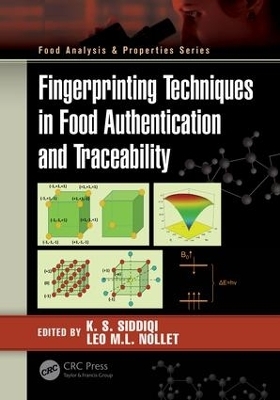
Fingerprinting Techniques in Food Authentication and Traceability
CRC Press (Verlag)
978-1-138-19767-1 (ISBN)
There is an increasing interest by consumers for high-quality food products with a clear geographical origin. With these products in demand, suitable analytical techniques are needed for the quality control. Current analytical approaches are mass spectrometry techniques, spectroscopic techniques, separation techniques, and others. Fingerprinting Techniques in Food Authentication and Traceability discusses the principles of the techniques together with their advantages and drawbacks, and reported applications concerning geographical authenticity. A combination of methods analyzing different types of food compounds seems to be the most promising approach to establish the geographical origin. The abundant acquired data are analyzed by chemometrics.
Producing safe and high-quality food is a prerequisite to ensure consumer health and successful domestic and international trade, and is critical to the sustainable development of national agricultural resources.
Systems to trace food or feed products through specified stages of production, processing, and distribution play a key role in assuring food safety. Analytical techniques that enable the provenance of food to be determined provide an independent means of verifying traceability systems and also help to prove product authenticity, to combat fraudulent practices and to control adulteration, which are important issues for economic, religious, or cultural reasons.
Proof of provenance has become an important topic in the context of food safety, food quality, and consumer protection in accordance with national legislation and international standards and guidelines.
Khwaja Salahuddin Siddiqi, PhD, earned his PhD in 1973 from Aligarh Muslim University, Aligarh,India; his thesis was on the Complexes of Group (IV) Elements. He also earned his undergraduate degrees at Aligarh Muslim University. He conducted postdoctural research at the University of Barcelona, Spain, and the University of Provence, Marseille, France. He has taught numerous graduate level courses including Spectroscopy, Bioinorganic Chemistry, Solid State Chemistry, and Organometallic Chemistry. He has guided the Ph.D. work of 22 students. His research areas include Nano Chemistry, Organoborate Chemistry, Organometallic Chemistry, and Bioinorganic Chemistry, and he has published over 160 papers and has presented at 120 national and international conferences. Leo M.L. Nollet, PhD, received an MS (1973) and PhD (1978) in biology from the Katholieke Universiteit Leuven, Belgium. He is an editor and associate editor of numerous books. He edited for M. Dekker, New York—now CRC Press of Taylor & Francis—the first, second, and third editions of the books entilted Food Analysis by HPLC and Handbook of Food Analysis. The last edition is a two volume book. He also edited the Handbook of Water Analysis (first, second, and third editions) and Chromatographic Analysis of the Environment, Third Edition (CRC Press). Dr. Nollet’s recent projects include Proteomics in Foods with F. Toldrá (Springer, 2013) and Transformation Products of Emerging Contaminants in the Environment: Analysis, Processes, Occurrence, Effects and Risks with D. Lambropoulou (Wiley, 2014). In this series, CRC Food Analysis & Properties, he edited with C. Ruiz-Capillas, Flow Injection Analysis of Food Additives (CRC Press, 2015).
Techniques. ICP-MS – LC-MS – GC-MS. Spectroscopic methods – FTIR – NIR. NMR. CE. Flow Injection – MS. DART MS – PTR MS. DNA-based methodologies. Authentication and Traceability. Authentication. Traceability. Multivariate Statistical Techniques. Experimental Design. Data Preprocessing. Classification and Modelling Methods. Validation. Applications. Rice. Wines. Honeys. Meat. Marine Species. Fruit and Vegetables. Chocolate.
| Erscheinungsdatum | 18.10.2018 |
|---|---|
| Reihe/Serie | Food Analysis & Properties |
| Zusatzinfo | 29 Tables, black and white; 11 Illustrations, color; 27 Illustrations, black and white |
| Verlagsort | London |
| Sprache | englisch |
| Maße | 178 x 254 mm |
| Gewicht | 1090 g |
| Themenwelt | Naturwissenschaften ► Chemie ► Analytische Chemie |
| Technik ► Lebensmitteltechnologie | |
| ISBN-10 | 1-138-19767-X / 113819767X |
| ISBN-13 | 978-1-138-19767-1 / 9781138197671 |
| Zustand | Neuware |
| Haben Sie eine Frage zum Produkt? |
aus dem Bereich


